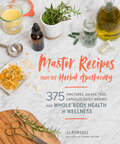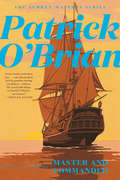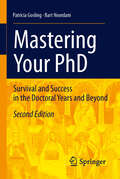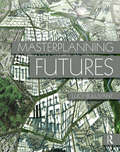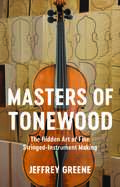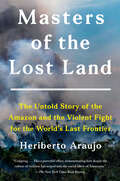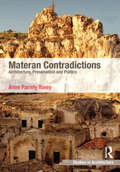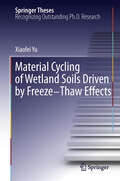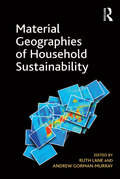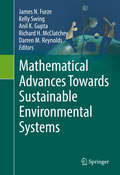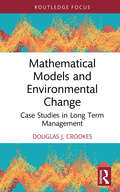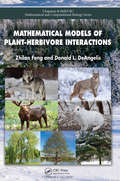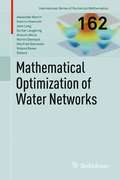- Table View
- List View
Master And Commander
by Patrick O'BrianThis novel establishes the friendship between Captain Aubrey, R. N., and Stephen Maturin, ship's surgeon and intelligence agent, against the thrilling backdrop of the Napoleonic wars.
Master Recipes from the Herbal Apothecary: 375 Tinctures, Salves, Teas, Capsules, Oils, and Washes for Whole-Body Health and Wellness
by JJ Pursell“This incredible, in-depth, and easy-to-access resource is a must for all of us who wish to learn more about healing ourselves through the plant world.” —Shiva Rose, actress, activist, and founder of The Local Rose JJ Pursell, the bestselling author of The Herbal Apothecary, is back with a complete, one-stop resource for herbal remedies that heal and nurture the whole family. Master Recipes from the Herbal Apothecary offers safe, trusted natural remedies written by a board-certified naturopathic physician. It starts with master recipes for tinctures, salves, teas, capsules, oils, washes, and more. Once you understand how to make these basic formulations, you can access the more than 375 specific recipes that address a range of health concerns from the common cold and headaches to insomnia and digestive issues. Comprehensive, thoroughly researched, and beautifully packaged, Master Recipes from the Herbal Apothecary will become your go-to guide for sustained health and wellness.
Master Your Craft: Strategies for Designing, Making, and Selling Artisan Work
by Tien ChiuDo you want to create unique, brilliantly designed works of craft? Make the most of your studio time? Develop your artistic "voice," skills, and career? Then this book is for you. Written by award-winning textile artist Tien Chiu, Master Your Craft: Strategies for Designing, Making, and Selling Artisan Work provides sharp insight into the creative process, from the first spark of inspiration to careful contemplation of the finished piece. Perspectives from 22 master artisans fuse with industrial product design techniques and the author's own craft experience to offer a powerful framework for designing, making, and selling your work. Master Your Craft outlines a powerful process for designing and creating beautiful work. It enables you to: Discover inspiration even in the most mundane things Brainstorm unique designs Refine your designs into visually powerful, useful work that is practical to make and sell Transform your creative process to work more enjoyably and effectively Take your design and construction skills to the next level Identify your distinctive personal style Create a career for yourself, either as an artist or an artisan. Packed with advice from master woodworkers, glass workers, ceramicists, textile artists, metalworkers, and more, Master Your Craftwill enable you to create stunning pieces and - if you choose - develop your craft into a career.
Master and Commander (Aubrey/Maturin Novels #(Vol. Book 1))
by Patrick O'BrianThis, the first in the splendid series of Jack Aubrey novels, establishes the friendship between Captain Aubrey, R.N., and Stephen Maturin, ship's surgeon and intelligence agent, against a thrilling backdrop of the Napoleonic wars. Details of a life aboard a man-of-war in Nelson's navy are faultlessly rendered: the conversational idiom of the officers in the ward room and the men on the lower deck, the food, the floggings, the mysteries of the wind and the rigging, and the roar of broadsides as the great ships close in battle.
Master of Thin Air: Life and Death on the World's Highest Peaks
by Andrew Lock Peter HillaryNamed one of the "Five Adventure Books You Need to Read This Summer” by Backpacker MagazineFor readers of Into Thin Air, riveting high-altitude drama and the passion and drive that inspire outsized mountaineering achievements.Master of Thin Air opens with a fall that the author very nearly could not stop down an almost vertical rock ramp leading to a three-thousand-foot drop. The qualities that saved him then on K2-in addition to his mountaineering know-how and sheer good luck-drove his sixteen-year journey to summit all of the world's eight-thousanders, the fourteen peaks that exceed 8,000 meters (26,000-plus feet) and take climbers into the death zone. Incredibly, he accomplished that feat without the aid of bottled oxygen for every mountain but one. By preference, he climbed solo or in small teams, without Sherpas. During twenty-three expeditions, he spent a total of three years clinging to the sides of dangerous mountains. He lost more than twenty climbing friends and, in April 2014, witnessed Everest's deadliest avalanche.His book is a riveting, often thrilling account of what it takes to challenge the Earth's highest peaks and survive. It tells of death-defying ascents and even riskier descents, the gut-dropping consequences of the smallest mistakes or even just bad luck, the camaraderie and human drama of expeditions, the exhilaration of altitude. It is also the inspiring story of what motivates a person to achieve an extraordinary dream, a story of passion, resourcefulness, self-motivation, and hope-even in the most dire moments.Skyhorse Publishing, as well as our Sports Publishing imprint, is proud to publish a broad range of books for readers interested in sports-books about baseball, pro football, college football, pro and college basketball, hockey, or soccer, we have a book about your sport or your team.In addition to books on popular team sports, we also publish books for a wide variety of athletes and sports enthusiasts, including books on running, cycling, horseback riding, swimming, tennis, martial arts, golf, camping, hiking, aviation, boating, and so much more. While not every title we publish becomes a New York Times bestseller or a national bestseller, we are committed to publishing books on subjects that are sometimes overlooked by other publishers and to authors whose work might not otherwise find a home.
Mastering Precision Piecing: 7 Spectacular Quilts with Techniques for Success
by Sally CollinsLearn Precision Piecing from an Award-Winning Expert • The must-have book to take your quilting to the expert level • 7 new projects • Tips to improve your skills at every step of the quilting process • Learn to create the perfect 1/4" seam, sew straight, and chain piece for efficiency • Hundreds of illustrations and photos for clear direction • Use color like Sally for exquisite results Sally shows you how to bring accuracy to every step: pinning, cutting, sewing, and pressing. Seven pieced projects range from a miniature quilt to a large wallhanging. The projects use intermediate to advanced skills; two include appliqué.
Mastering Your PhD
by Lambertus D. Noordam Patricia Gosling"Mastering Your PhD: Survival and Success in the Doctoral Years and Beyond" helps guide PhD students through their graduate student years. Filled with practical advice on getting started, communicating with your supervisor, staying the course, and planning for the future, this book is a handy guide for graduate students who need that extra bit of help getting started and making it through. While mainly directed at PhD students in the sciences, the book's scope is broad enough to encompass the obstacles and hurdles that almost all PhD students face during their doctoral training. Who should read this book? Students of the physical and life sciences, computer science, math, and medicine who are thinking about entering a PhD program; doctoral students at the beginning of their research; and any graduate student who is feeling frustrated and stuck. It's never too early -- or too late! This second edition contains a variety of new material, including additional chapters on how to communicate better with your supervisor, dealing with difficult people, how to find a mentor, and new chapters on your next career step, once you have your coveted doctoral degree in hand.
Masterminding Nature
by Margaret DerryIn Masterminding Nature, Margaret Derry examines the evolution of modern animal breeding from the invention of improved breeding methodologies in eighteenth-century England to the application of molecular genetics in the 1980s and 1990s. A clear and concise introduction to the science and practice of artificial selection, Derry's book puts the history of breeding in its scientific, commercial, and social context.Masterminding Nature explains why animal breeders continued to use eighteenth-century techniques well into the twentieth century, why the chicken industry was the first to use genetics in its breeding programs, and why it was the dairy cattle industry that embraced quantitative genetics and artificial insemination in the 1970s, as well as answering many other questions. Following the story right up to the present, the book concludes with an insightful analysis of today's complex relationships between biology, industry, and ethics.
Masterplanning Futures
by Lucy BullivantWinner of the Urban Design Group's 2014 Book of the Year Award! In the past, spatial masterplans for cities have been fixed blueprints realized as physical form through conventional top down processes. These frequently disregarded existing social and cultural structures, while the old modernist planning model zoned space for home and work. At a time of urban growth, these models are now being replaced by more adaptable, mixed use plans dealing holistically with the physical, social and economic revival of districts, cities and regions. Through today’s public participative approaches and using technologically enabled tools, contemporary masterplanning instruments embody fresh principles, giving cities a greater resilience and capacity for social integration and change in the future. Lucy Bullivant analyses the ideals and processes of international masterplans, and their role in the evolution of many different types of urban contexts in both the developed and developing world. Among the book’s key themes are landscape-driven schemes, social equity through the reevaluation of spatial planning, and the evolution of strategies responding to a range of ecological issues and the demands of social growth. Drawing on first-hand accounts and illustrated throughout with colour photographs, plans and visualizations, the book includes twenty essays introduced by an extensive overview of the field and its objectives. These investigate plans including one-north Singapore, Masdar City in Abu Dhabi, Xochimilco in Mexico City and Waterfront Seattle, illuminating their distinct yet complementary integrated strategies. This is a key book for those interested in today’s multiscalar masterplanning and conceptually advanced methodologies and principles being applied to meet the challenges and opportunities of the urbanizing world. The author's research was enabled by grants from the Commission for Architecture and the Built Environment (CABE), the SfA (the Netherlands Architecture Fund), the Danish Embassy and support from the Alfred Herrhausen Society.
Masters of Tonewood: The Hidden Art of Fine Stringed-Instrument Making
by Jeffrey GreeneThe wood used by master craftsmen to create many of the world’s legendary stringed instruments—violins and cellos, mandolins and guitars—comes from seven near-mythic European forests. In his latest book, Jeffrey Greene takes the reader into those woodlands and into luthiers’ workshops to show us how the world’s finest instruments not only contribute to great musical art but are prized works of art in themselves.Masters of Tonewood describes the "hidden life" of stringed instruments, beginning with the unique wood, expertly chosen and sometimes cured for decades, that gives them voices that rivet audiences. Greene takes us to forests in Italy, France, Switzerland, Austria, Romania, Poland, and the Czech Republic. We are introduced to the acoustical and aesthetic properties of the spruce that Stradivari treasured, and the mystery of why just one in a thousand maple trees contains decorative figuring worthy of the highest-quality instruments. Greene visits the greatest traditional centers of this craft, from Spain to the United States. He recounts the ideas and experiences of tonewood millers, luthiers, and musicians and discusses their concerns about environmental issues associated with a tradition dependent on ancient woodlands in a modern world.
Masters of the Lost Land: The Untold Story of the Amazon and the Violent Fight for the World's Last Frontier
by Heriberto AraujoIn the tradition of Killers of the Flower Moon, a haunting murder mystery revealing the human story behind one of the most devastating crimes of our time: the ruthless destruction of the Amazon rain forest—and anyone who stands in the wayDeep in the heart of the Amazon, the city of Rondon do Pará, Brazil, lived for decades in the shadow of land barons, or fazendeiros, who maintained control of the region through unscrupulous land grabs and egregious human rights violations. They razed and burned the jungle, expelled small-scale farmers and Indigenous tribes from their lands, and treated their farmhands as slaves—all with impunity. The only true opposition came from Rondon’s small but robust farmworkers’ union, led by the charismatic Dezinho, who fought to put power back into the hands of the people who called the Amazon home. But when Dezinho was assassinated in cold blood, it seemed the farmworkers’ struggle had come to a violent and fruitless end.What no one anticipated was that this event would bring forth an unlikely hero: Dezinho’s widow. Against great odds, and at extreme personal risk, Maria Joel, now a single mother of four young children, used her ingenuity and unwavering support from union members to bring her husband’s killer to account in court. Her campaign gained unexpected momentum, helping to bring international attention to the dire situation in Rondon, from Brazil’s president Lula to international celebrities and civil rights groups.Maria Joel’s fight for justice had far-reaching implications: it unearthed a chilling world of corruption and lawlessness rooted in Brazil’s quest to turn the largest rain forest on earth into an economic frontier. As more details came out, it began to look increasingly likely that Dezinho’s killer, a reluctant and inexperienced gunman, was just one piece of a larger criminal consortium, with ties leading all the way up to one of the region’s most powerful and notorious fazendeiros of all.Featuring groundbreaking revelations and exclusive interviews, this gripping work of narrative nonfiction is the culmination of journalist Heriberto Araujo’s years-long investigation in the heart of the Amazon. Set against the backdrop of appalling deforestation rates and resultant superfires, Masters of the Lost Land vividly reveals the human story behind the loss of—and fierce crusade to protect—one of our greatest resources in the fight against climate change and one of the last wild places on earth.
Materan Contradictions: Architecture, Preservation and Politics (Ashgate Studies In Architecture Ser.)
by Anne Parmly ToxeyShaped by encrusted layers of development spanning millennia, the southern Italian city of Matera is the ultimate palimpsest. Known as the Sassi, the majority of the ancient city is composed of thousands of structures carved into a limestone cliff and clinging to its walls. The resultant menagerie of forms possesses a surprising visual uniformity and an ineffable allure. Conversely, in the 1950s Matera also served as a crucible for Italian postwar urban and architectural theory, witnessed by the Neorealist, modernist expansion of the city that developed in aversion to the Sassi. In another about-face, the previously disparaged cave city has now been recast as a major tourist destination, UNESCO World Heritage Monument, and test subject for ideas and methods of preservation. Set within a sociopolitical and architectural history of Matera from 1950 to the present, this book analyses the contemporary effects of preservation on the city and surrounding province. More broadly, it examines the relationship between and interdependence of preservation and modernism within architectural thought. To understand inconsistencies inherent to preservation, in particular its effect of catalyzing change, the study lays bare planners' and developers' use of preservation, especially for economic goals and political will. The work asserts that preservation is not a passive, curatorial pursuit: it is a cloaked manifestation of modernism and a powerful tool often used to control economies. The study demonstrates that preservation also serves to influence societies through the shaping of memory and circulation of narratives.
Material Cycling of Wetland Soils Driven by Freeze-Thaw Effects
by Xiaofei YuFreezing and thawing of soils is a common phenomenon in the winter-cold zone. The thesis titled "Material Cycling of Wetland Soils Driven by Freeze-Thaw Effects" systematically explores the freeze-thaw effects on the accumulation and release processes of carbon and nitrogen in wetland soils, which is a good step toward the investigation of biogeochemical processes in wetlands in seasonal freeze-thaw areas. It is also developing strategies aimed at global warming effects on the accumulation and release of carbon and nitrogen in wetlands. Dr. Xiaofei Yu works at the Northeast Institute of Geography and Agroecology, Chinese Academy of Sciences, China.
Material Ecocriticism
by Serenella Iovino Serpil OppermannMaterial Ecocriticism offers new ways to analyze language and reality, human and nonhuman life, mind and matter, without falling into well-worn paths of thinking. Bringing ecocriticism closer to the material turn, the contributions to this landmark volume focus on material forces and substances, the agency of things, processes, narratives and stories, and making meaning out of the world. This broad-ranging reflection on contemporary human experience and expression provokes new understandings of the planet to which we are intimately connected.
Material Geographies of Household Sustainability
by Andrew Gorman-MurrayCharting new research directions, this book constructs a series of imperatives for linking culturally informed research around household sustainability with policy and planning. The household, or 'home', is a critical scale for understanding activities that connect individual behaviours and societal attitudes. The focus on the household in this collection provides a window into the sheer diversity of homemaking and maintenance activities that entail resource use. These practices have affective or emotive dimensions as well as habitual aspects. Diversity, innovation and change at the household scale is often missed in policy approaches which assume that simplistic economic motivations drive demand and this can in turn be 'managed' through regulation or market pricing. The research challenge extends beyond describing existing unsustainable economies driving resource intensive behaviour to consider realistic options for transformations in cultural practices, material relationships and, ultimately, the political economies they sit within. Without change in these systems, government initiatives to promote ecological modernisation run the risk of simply green-washing the very economies of consumption that currently drive unsustainable practices. Social and cultural change at the household level is critical to promoting sustainability at a range of wider scales.
Material Science and Environmental Engineering: Proceedings of the 3rd Annual 2015 International Conference on Material Science and Environmental Engineering (ICMSEE2015, Wuhan, Hubei, China, 5-6 June 2015)
by Ping ChenMaterial Science and Environmental Engineering presents novel and fundamental advances in the fields of material science and environmental engineering. Collecting the comprehensive and state-of-art in these fields, the contributions provide a broad overview of the latest research results, so that it will proof to be a valuable reference book to aca
Material: Making and the Art of Transformation
by Nick KaryA master craftsperson explores the ways in which working with our hands reveals the essence of both our humanity and our relationship with the natural, material world In our present age of computer-assisted design, mass production and machine precision, the traditional skills of the maker or craftsperson are hard to find. Yet the desire for well-made and beautiful objects from the hands (and mind) of a skilled artisan is just as present today as it ever has been. Whether the medium they work with is wood, metal, clay or something else, traditional makers are living links to the rich vein of knowledge and skills that defines our common human heritage. More than this, though, many of us harbor a deep and secret yearning to produce something – to build or shape, to imagine and create our own objects that are imbued not only with beauty and functionality, but with a story and, in essence, a spirit drawn from us. Nick Kary understands this yearning. For nearly four decades he has worked on commission to make fine, distinctive furniture and cabinets from wood, most of it sourced near his home, in the counties of South West England. During this time, he has been both a teacher and a student; one who is fascinated with the philosophy and practice of craft work of all kinds. In Material, Kary takes readers along with him to visit some of the places where modern artisans are preserving, and in some cases passing on, the old craft skills. His vivid descriptions and eye for detail make this book a rich and delightful read, and the natural and cultural history he imparts along the way provides an important context for understanding our own past and the roots of our industrial society. Personal, engaging, and filled with memorable people, landscapes and scenes, Material is a rich celebration of what it means to imagine and create, which in the end is the essence of being human, and native to a place. As Kary puts it, “Wood and words, trees and people, material and ethereal – it is here I love increasingly to dwell.”
Materials and Sustainability: Building a Circular Future
by Julia L Goldstein Paul Foulkes-ArellanoThis book examines sustainable manufacturing, from the extraction of materials to processing, use, and disposal, and argues that significant changes in all of the above are needed for the world to progress toward a more circular economy.Materials and processing methods are usually chosen with performance as the key metric. Why has our society embraced plastics? Because they work. In most cases, they are lighter, easier to manufacture, and less expensive than the metal, wood, glass, or stone they have replaced. Why do industrial manufacturers use toxic chemicals? Because they are effective, but the unintended consequences may be severe. By learning how various materials are made and what happens when they are recycled, readers will better understand the value of materials and the challenges that manufacturers face when trying to make their facilities and products less toxic and less wasteful. The three chapters in Part I provide essential background about materials in the circular economy, chemicals, and waste. Part II delves into specific materials. It includes chapters on plastics, metals, wood and paper products, glass, and novel materials. Part III covers recycling and manufacturing processes, and Part IV delves into practical considerations, including the effect of regulations, concluding with a chapter that helps readers translate the information presented into action. Interviews with industry experts round out the chapters and offer valuable insights.Materials and Sustainability is a must-read for business professionals who are serious about making their companies as environmentally responsible as possible and for business and engineering students who want to begin their careers with practical knowledge about materials and their impacts.
Mathematical Advances Towards Sustainable Environmental Systems
by Anil K. Gupta Darren M. Reynolds James N. Furze Kelly Swing Richard H. McclatcheyThis edited volume focuses on how we can protect our environment and enhance environmental sustainability when faced with changes and pressures imposed by our expansive needs. The volume unites multiple subject areas within sustainability, enabling the techniques and philosophy in the chapters to be applied to research areas in environmental science, plant sciences, energy, biodiversity and conservation. The chapters from expert contributors cover topics such as mathematical modelling tools used to monitor diversity of plant species, and the stability of ecosystem services such as biogeochemical cycling. Empirical research presented here also brings together mathematical developments in the important fields of robotics including kinematics, dynamics, path planning, control, vision, and swarmanoids. Through this book readers will also discover about rainfall-runoff modelling which will give them a better idea of the effects of climate change on the sustainability of water resources at the watershed scale. Modelling approaches will also be examined that maximize readers insights into the global problem of energy transition, i. e. the switch to an energy production system using renewable resources only. Collective and discrete insights are made to assist with synergy which should progress well beyond this book. Insight is also given to assist policy formations, development and implementations. The book has a strong multi-disciplinary nature at its core, and will appeal to both generalist readers and specialists in information technology, mathematics, biology, physics, chemistry and environmental sciences.
Mathematical Models and Environmental Change: Case Studies in Long Term Management (Routledge Focus on Environment and Sustainability)
by Douglas J. CrookesThis book demonstrates how mathematical models constructed in system dynamics modelling platforms, such as Vensim, can be used for long-term management of environmental change. It is divided into two sections, with the first dedicated to theory, where the theory of co-evolutionary modelling and its use in the system dynamics model platform is developed. The book takes readers through the steps in the modelling process, different validation tools applicable to these types of models and different growth specification, as well as how to curve fit using numerical methods in Vensim. Section 2 comprises of a collection of applied case studies, including fisheries, game theory and wildlife management. The book concludes with lessons from the use of co-evolutionary models for long-term natural resource management. The book will be of great interest to students and scholars of environmental economics, natural resource management, system dynamics, ecological modelling and bioeconomics.
Mathematical Models of Plant-Herbivore Interactions (Chapman & Hall/CRC Mathematical Biology Series)
by Zhilan Feng Donald DeAngelisMathematical Models of Plant-Herbivore Interactions addresses mathematical models in the study of practical questions in ecology, particularly factors that affect herbivory, including plant defense, herbivore natural enemies, and adaptive herbivory, as well as the effects of these on plant community dynamics. <P><P> The result of extensive research on the use of mathematical modeling to investigate the effects of plant defenses on plant-herbivore dynamics, this book describes a toxin-determined functional response model (TDFRM) that helps explains field observations of these interactions. <P><P> This book is intended for graduate students and researchers interested in mathematical biology and ecology.
Mathematical Optimization of Water Networks (International Series Of Numerical Mathematics Series #162)
by Martin Oberlack Günter Leugering Kathrin Klamroth Jens Lang Alexander Martin Antonio Morsi Manfred Ostrowski Roland RosenWater supply- and drainage systems and mixed water channel systems are networks whose high dynamic is determined and/or affected by consumer habits on drinking water on the one hand and by climate conditions, in particular rainfall, on the other hand. According to their size, water networks consist of hundreds or thousands of system elements. Moreover, different types of decisions (continuous and discrete) have to be taken in the water management. The networks have to be optimized in terms of topology and operation by targeting a variety of criteria. Criteria may for example be economic, social or ecological ones and may compete with each other. The development of complex model systems and their use for deriving optimal decisions in water management is taking place at a rapid pace. Simulation and optimization methods originating in Operations Research have been used for several decades; usually with very limited direct cooperation with applied mathematics. The research presented here aims at bridging this gap, thereby opening up space for synergies and innovation. It is directly applicable for relevant practical problems and has been carried out in cooperation with utility and dumping companies, infrastructure providers and planning offices. A close and direct connection to the practice of water management has been established by involving application-oriented know-how from the field of civil engineering. On the mathematical side all necessary disciplines were involved, including mixed-integer optimization, multi-objective and facility location optimization, numerics for cross-linked dynamic transportation systems and optimization as well as control of hybrid systems. Most of the presented research has been supported by the joint project „Discret-continuous optimization of dynamic water systems“ of the federal ministry of education and research (BMBF).
Mathematical Paradigms of Climate Science
by Christopher Jones Piermarco Cannarsa Fabio Ancona Alessandro PortaluriThis book, featuring a truly interdisciplinary approach, provides an overview of cutting-edge mathematical theories and techniques that promise to play a central role in climate science. It brings together some of the most interesting overview lectures given by the invited speakers at an important workshop held in Rome in 2013 as a part of MPE2013 ("Mathematics of Planet Earth 2013"). The aim of the workshop was to foster the interaction between climate scientists and mathematicians active in various fields linked to climate sciences, such as dynamical systems, partial differential equations, control theory, stochastic systems, and numerical analysis. Mathematics and statistics already play a central role in this area. Likewise, computer science must have a say in the efforts to simulate the Earth's environment on the unprecedented scale of petabytes. In the context of such complexity, new mathematical tools are needed to organize and simplify the approach. The growing importance of data assimilation techniques for climate modeling is amply illustrated in this volume, which also identifies important future challenges.
Mathematics in Nature: Modeling Patterns in the Natural World
by John AdamFrom rainbows, river meanders, and shadows to spider webs, honeycombs, and the markings on animal coats, the visible world is full of patterns that can be described mathematically. Examining such readily observable phenomena, this book introduces readers to the beauty of nature as revealed by mathematics and the beauty of mathematics as revealed in nature. Generously illustrated, written in an informal style, and replete with examples from everyday life, Mathematics in Nature is an excellent and undaunting introduction to the ideas and methods of mathematical modeling. It illustrates how mathematics can be used to formulate and solve puzzles observed in nature and to interpret the solutions. In the process, it teaches such topics as the art of estimation and the effects of scale, particularly what happens as things get bigger. Readers will develop an understanding of the symbiosis that exists between basic scientific principles and their mathematical expressions as well as a deeper appreciation for such natural phenomena as cloud formations, halos and glories, tree heights and leaf patterns, butterfly and moth wings, and even puddles and mud cracks. Developed out of a university course, this book makes an ideal supplemental text for courses in applied mathematics and mathematical modeling. It will also appeal to mathematics educators and enthusiasts at all levels, and is designed so that it can be dipped into at leisure.
Mathematics of Planet Earth: Protecting Our Planet, Learning from the Past, Safeguarding for the Future (Mathematics of Planet Earth #5)
by Hans G. Kaper Fred S. RobertsSince its inception in 2013, Mathematics of Planet Earth (MPE) focuses on mathematical issues arising in the study of our planet. Interested in the impact of human activities on the Earth’s system, this multidisciplinary field considers the planet not only as a physical system, but also as a system supporting life, a system organized by humans, and a system at risk. The articles collected in this volume demonstrate the breadth of techniques and tools from mathematics, statistics, and operations research used in MPE. Topics include climate modeling, the spread of infectious diseases, stability of ecosystems, ecosystem services, biodiversity, infrastructure restoration after an extreme event, urban environments, food security, and food safety. Demonstrating the mathematical sciences in action, this book presents real-world challenges for the mathematical sciences, highlighting applications to issues of current concern to society. Arranged into three topical sections (Geo- and Physical Sciences; Life Sciences, Ecology and Evolution; Socio-economics and Infrastructure), thirteen chapters address questions such as how to measure biodiversity, what mathematics can say about the sixth mass extinction, how to optimize the long-term human use of natural capital, and the impact of data on infrastructure management. The book also treats the subject of infectious diseases with new examples and presents an introduction to the mathematics of food systems and food security. Each chapter functions as an introduction that can be studied independently, offering source material for graduate student seminars and self-study. The range of featured research topics provides mathematical scientists with starting points for the study of our planet and the impact of human activities. At the same time, it offers application scientists a plethora of modern mathematical tools and techniques to address the various topics in practice. Including hundreds of references to the vast literature associated with each topic, this book serves as an inspiration for further research.

